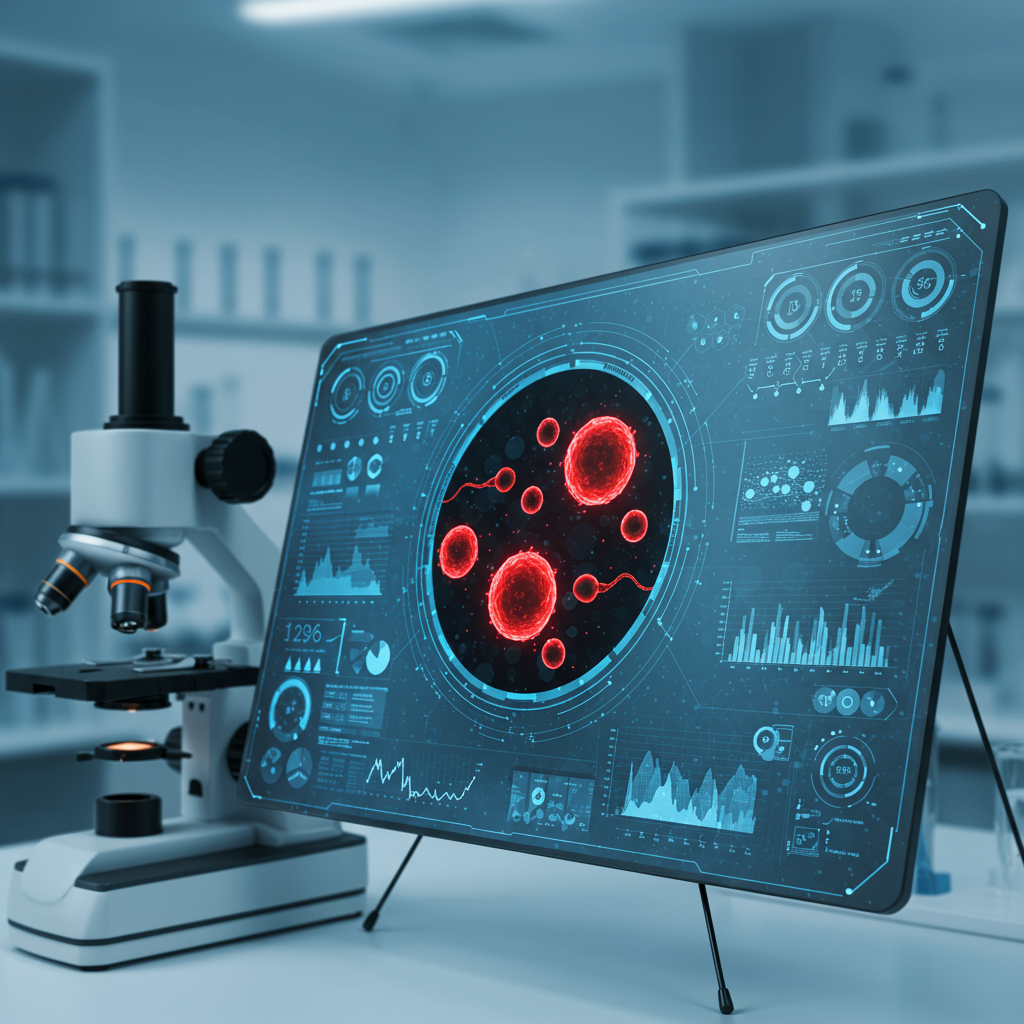Facing infertility can be a deeply challenging experience, particularly when severe male factor issues are present. For couples where viable sperm are extremely rare or difficult to find, the dream of having a biological child can feel impossible. Traditional methods for locating these elusive sperm cells are often painstakingly slow, relying heavily on human expertise to search vast samples under a microscope—a process akin to finding a tiny needle in a massive haystack.
However, cutting-edge advancements in reproductive technology are now offering profound new hope. Artificial intelligence (AI) is fundamentally changing this complex process, dramatically accelerating the identification and isolation of viable sperm. This innovation is not just about speed; it’s about opening doors for individuals and couples who previously had limited or no viable options, promising to reshape the landscape of male infertility treatment and make parenthood attainable for more families.
The Significant Challenge of Finding Rare Sperm
Male infertility impacts millions of people worldwide. While causes vary, including genetic factors, hormonal imbalances, or past medical issues, a significant hurdle arises in cases of severely low sperm count, poor motility, or abnormal shape. Conditions like non-obstructive azoospermia (NOA) are particularly challenging. In NOA, the testes produce very few sperm, often hidden within tissue, making their detection through standard methods nearly impossible. This condition affects about 1 in 100 men and is a major cause of male infertility.
For those pursuing assisted reproductive technologies like IVF (in vitro fertilization) or ICSI (intracytoplasmic sperm injection), finding even a single healthy sperm is absolutely crucial. The standard approach involves highly skilled embryologists manually scanning samples under a microscope for hours, sometimes even days. This process is not only labor-intensive and prone to human fatigue but also inherently subjective. Distinguishing between viable but non-moving sperm and non-viable cells is difficult. When viable sperm are exceptionally rare, the chances of missing them, despite extensive effort, are high. The emotional and financial toll on couples during this prolonged waiting period is immense, underscoring the urgent need for a more efficient and objective method.
Limitations of Manual Sperm Search Methods
Manually searching millions of cells under a microscope is incredibly tedious and subject to human limitations. Embryologists use specific criteria like movement and appearance to assess sperm viability. However, subtle signs of viability in non-motile sperm are easily overlooked. In samples from men with severe conditions like NOA, viable sperm are sparse, often buried among other cell types. The sheer volume of material to examine means that even highly trained eyes can miss rare, viable candidates, even after searching for 48 hours straight, as seen in some clinical cases. This inherent inefficiency and potential for error in traditional sperm selection methods highlight the critical need for technological assistance capable of rapidly and objectively processing complex biological samples.
How AI is Revolutionizing Sperm Identification
The integration of artificial intelligence into reproductive medicine represents a pivotal shift. By leveraging sophisticated machine learning algorithms and advanced imaging technology, AI systems can now perform the arduous task of finding viable sperm at an unprecedented scale and speed. This is particularly impactful for individuals facing severe male infertility challenges like azoospermia.
A leading example is the STAR (Sperm Tracking and Recovery) system developed by researchers at Columbia University Fertility Center, led by Dr. Zev Williams. This AI breakthrough combines high-resolution microscopy with powerful software. A high-speed camera captures millions of images from a semen sample, or even a sample from testicular tissue extraction used in NOA cases. Unlike human examination, which is sequential and limited by attention span, the AI system can process vast datasets from the sample almost simultaneously.
The AI is trained on thousands of images of known viable and non-viable sperm. It learns to identify subtle patterns, characteristics, and even minimal movements that indicate viability, processing up to 8 million images per hour. This capability allows it to quickly scan and analyze millions of potential cells within a sample.
AI Speed and Accuracy in Finding Rare Sperm
This AI-powered approach drastically cuts down search time from potentially days to just hours. The AI rapidly analyzes vast numbers of cells, flagging or isolating those that meet viability criteria based on its extensive training data. This swift identification allows fertility specialists to quickly pinpoint the most promising sperm for fertilization procedures like ICSI. The gain in efficiency is enormous, reducing laboratory time, minimizing potential sample degradation, and significantly shortening the stressful waiting period for couples. AI also enhances accuracy because its assessment is consistent and data-driven, free from human fatigue or subjective interpretation.
A notable success story demonstrating this technology’s power involves a New York couple who had faced infertility for 20 years, enduring 15 failed IVF cycles due to the husband’s azoospermia. Traditional manual searches over 48 hours yielded no viable sperm. However, when the STAR system was employed, it located 44 viable sperm cells in just one hour. This allowed them to proceed with IVF, resulting in a successful pregnancy in March 2025. Similarly, an 18-year journey ended with a successful pregnancy using this method after it identified viable sperm where manual methods failed. These real-world outcomes highlight the tangible impact AI sperm selection can have on overcoming severe male fertility obstacles.
Broader AI Potential in Reproductive Medicine
The successful application of AI in identifying rare sperm is just one facet of its potential to transform reproductive health. AI is being explored and utilized in various other areas. Researchers at institutions like the University of British Columbia (UBC), including Dr. Ryan Flannigan and Dr. Hongshen Ma, are developing AI models to accelerate the search for rare sperm in testicular tissue samples for NOA patients, aiming for clinical trials within years.
Beyond sperm selection, AI tools are being developed to assess egg quality (like the CHLOE system), predict embryo viability, and personalize IVF treatment protocols based on individual patient data. As AI systems process more data and become more sophisticated, their ability to identify the most promising gametes and embryos is expected to improve significantly.
This could lead to higher success rates for assisted reproductive technologies, potentially reducing the number of treatment cycles needed and lowering overall costs and emotional burdens for couples. For men with severe sperm production issues, AI offers renewed hope where conventional methods might have failed. It could make procedures like ICSI more accessible and successful for a wider range of patients, even those with extremely low counts.
Exploring Revolutionary Solutions with AI
Beyond searching existing samples, AI is integral to more revolutionary research aimed at solving severe male infertility, particularly for patients who produce no sperm. At UBC, researchers are exploring methods to grow sperm in the lab using 3D bioprinting technology. This involves creating miniature models of testicular tissue using patient-derived stem cells. AI and microfluidic chips are then used to test and understand the complex molecular interactions necessary for sperm production in vitro. Led by collaborators like Dr. Stephanie Willerth and Dr. Govind Kaigala, this integrated approach combines AI search tools with the potential to diagnose problems at a molecular level and eventually facilitate lab-grown sperm, offering a pathway for individuals currently without options, including young cancer survivors whose fertility was impacted by treatment.
Addressing Challenges and Ethical Considerations
While the potential benefits are immense, integrating AI into sensitive areas like fertility treatment requires careful consideration. Rigorous validation and testing are paramount to ensure the AI’s accuracy and reliability before widespread adoption. The cost of implementing such advanced technology, estimated around $3,000 for the STAR sperm retrieval service at Columbia, is also a factor for access.
Ethical discussions surrounding AI’s role in selecting genetic material, potential implications for future generations, and equitable access are ongoing and necessary. Transparency in how AI models make decisions is vital for clinical trust and patient understanding. There are also broader societal discussions about AI’s impact on population trends and the welfare of children conceived via these advanced means. These are complex conversations requiring thoughtful implementation and regulation as reproductive AI technologies advance.
However, for individual couples facing the heartbreak of severe male factor infertility, this AI breakthrough represents a significant leap forward. It is a testament to how cutting-edge technology, when combined with clinical expertise, can overcome biological barriers and offer genuine hope in the face of seemingly insurmountable challenges.
Frequently Asked Questions
How does AI actually find sperm faster than humans?
AI systems utilize machine learning trained on vast datasets of sperm images. They analyze millions of high-resolution images from a sample simultaneously, processing data much quicker than a human manually scanning sequentially. The AI identifies subtle characteristics and movements indicative of viable sperm based on its training, rapidly flagging potential candidates across the entire sample. This automated, parallel processing drastically reduces the time needed to locate rare sperm, from days of human effort to just hours for the AI.
Where can couples access or learn more about this AI sperm selection method?
This technology is primarily available at leading fertility clinics and research institutions specializing in severe male infertility and advanced assisted reproductive technologies, such as the Fertility Center at Columbia University which developed the STAR system. Couples interested in this approach, especially if facing severe male factor challenges like azoospermia, should consult with their current fertility specialist. They can inquire if their clinic utilizes or plans to implement AI-powered sperm selection techniques or seek referrals to centers that do. The STAR service cost is estimated at around $3,000.
Is this AI approach suitable for all types of male infertility?
This AI technology is particularly beneficial for men with severe male factor infertility, especially conditions like azoospermia or non-obstructive azoospermia (NOA), where viable sperm are extremely rare or difficult to locate through traditional manual searching in ejaculate or tissue samples. While AI may also offer benefits in selecting sperm in less severe cases by identifying better quality cells, its most revolutionary impact is for those with critically low or undetectable counts. For patients who produce no sperm at all, current AI search tools are not a solution, though AI is being used in research exploring lab-grown sperm options.
Conclusion
The integration of artificial intelligence into the vital process of finding viable sperm marks a true breakthrough in male infertility treatment. By enabling the rapid and accurate identification of even the rarest sperm cells within complex samples, AI offers powerful new hope to couples who previously had limited options. This technology transforms a process that once took days into mere hours, significantly reducing stress and enhancing the efficiency of assisted reproductive procedures like ICSI. While careful discussion of ethical considerations and broader societal impacts is necessary, the immediate benefit for individuals facing severe male factor infertility is undeniable. As AI continues to advance and be integrated with other revolutionary research like lab-grown sperm techniques, its role in expanding the possibilities of reproductive medicine will only grow, bringing the dream of parenthood closer for many.




